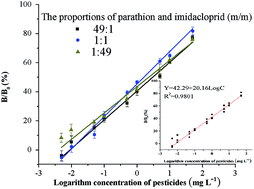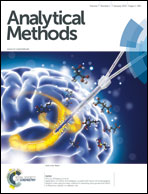Simultaneous detection of parathion and imidacloprid using broad-specificity polyclonal antibody in enzyme-linked immunosorbent assay
Abstract
A heterologous indirect competitive enzyme-linked immunosorbent assay (ic-ELISA) for the gross detection of parathion and imidacloprid residues is developed, based on a broad-specificity polyclonal antibody (BsPAb). Multi-determinant immunogen was prepared by conjugating parathion haptens and imidacloprid haptens to bovine serum albumin (BSA) in turns. The BsPAb was generated by immunized male New Zealand white rabbits with the multi-determinant immunogen. The effects of coating antigens on the performance of the ELISA were optimized for obtaining satisfactory assay sensitivity. Under the optimized conditions, the 50% inhibition concentration (IC50) value for parathion and imidacloprid mixture was 2.41 mg L−1, with a limit of detection (LOD) of 0.025 mg L−1. There was no obvious cross-reactivity (CR) with most of the neonicotinoids and organophosphorus insecticides, except for parathion–methyl (23.11%) and imidaclothiz (15.96%). The recoveries of parathion and imidacloprid in tap water samples ranged from 80.3% to 121%, and the relative standard deviation (RSD) were lower than 6.99%. The ELISA results were also confirmed by gas chromatography (GC). These results showed that the ic-ELISA can be used as a sensitive tool for detecting the gross (parathion and imidacloprid) in environmental samples.


 Please wait while we load your content...
Please wait while we load your content...